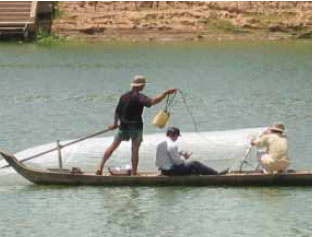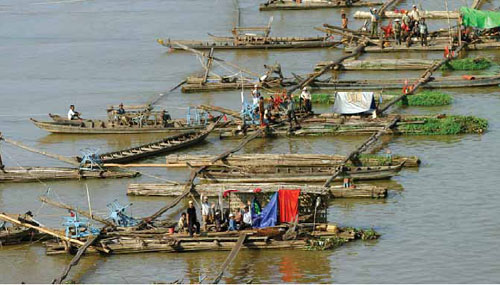FEATURES: Fisheries Consumption Report

The MRC Fisheries Programme, compiled a major report on Fish Consumption in 2007, providing valuable statistical information on the importance of fisheries in the Lower Mekong Basin. The report, entitled Consumption and the yield of fish and other aquatic animals from the Lower Mekong Basin (MRC Technical Paper No. 16, October 2007) was produced by the programme’s Fisheries Ecology, Valuation and Mitigation component, or FEVM .
Although various studies on fish consumption have in the past been carried out by different organisations, the results of these studies are not generally available or synthesised, so views on the size and value of the basin’s fisheries vary widely. The FEVM review attempted to estimate the yield (production) of the fishery based on data on consumption from 20 field surveys in the LMB, with some supporting analyses of complementary data.
So that data compiled by these surveys could be used to estimate province-level consumption, and also to extrapolate that data to provinces which had not been surveyed, the researchers had to make various adjustments. For instance, preserved fish amounts were adjusted to ‘fresh whole animal equivalent weights’. Other alterations were required to account for differences in coverage and units, while information on other animal products was also synthesised where available.
Based on the results of the 20 surveys, consumption of fish and other aquatic animals in the LMB was estimated to be about 2.6 million tonnes for a population of roughly 56 million. About one-third of this fish is preserved before consumption. Lao and Thai people on average eat about 25 kg of inland fish per person per year, while in Cambodia the figure is over 32 kg, and in Viet Nam almost 35 kg per year. Per capita consumption of inland fish and other aquatic animals averages 34 kg/year, providing 47–80% of animal protein, depending on the country.
Full explanation of the data in this table is available in MRC Technical Report No. 16 (October 2007)
| Cambodia | Lao PDR | Thailand | Viet Nam | ||
| Estimated per capita consumption of inland fish and other aquatic animals in the LMB* |
kg/capita/year Average |
||||
Inland fish |
32.3 | 24.5 | 24.9 | 34.5 | 29.3 |
Other aquatic animals (OAA) |
4.5 | 4.1 | 4.2 | 4.5 | 4.3 |
Total inland fish and OAAs |
36.8 | 28.6 | 29.0 | 39.0 | 33.7 |
| Estimated yield (tonnes/year as FWAEs) of inland fish and other aquatic animals in the LMB, based on consumption studies** |
kg/capita/year Total |
||||
Inland fish |
481,537 | 167,922 | 720,501 | 692,118 | 2,062,077 |
Other aquatic animals |
105,467 | 40,581 | 190,984 | 160,705 | 497,737 |
Total inland fish and OAAs |
587,004 | 208,503 | 911,485 | 852,823 | 2,559,815 |
* Based on consumption studies.
** Other studies, based on production from flooded areas, indicate
that fish production is higher in Cambodia, slightly lower in
Thailand and Viet Nam, and lower in the Lao PDR than indicated
in this table.
Various other data sets support the consumption estimates: results from one small monitoring study found very similar levels of actual consumption among some representative groups of people. Catch data was generally consistent with consumption data, while consumption data sets from elsewhere in the world indicate the LMB estimates are reasonable. Considering the unit area of aquatic habitat, global figures suggest a possible range of 0.7–2.9 million tonnes/year of aquatic harvest in the LMB. Given the Mekong’s high natural productivity and facts such as Cambodia’s status as a nett exporter of fish, it is most likely that actual yield is at the upper end of this range.

Consumption surveys like those conducted for this report can only give a rough picture of the overall situation: their real accuracy cannot truly be known. The data from this work could be complemented by further studies on yield per unit area, especially of rice-field habitats in the Lao PDR and Thailand. These would refine the overall estimate of yield from the basin. Land classed as rice-fields covers most of the LMB’s wetland areas, so paddy fields and related habitats make a large but poorly-understood contribution to total fisheries yield.
The yield estimate indicates an enormous fishery which is vital in terms of nutrition, livelihoods, food security and culture.
Various studies show that most of the basin’s inhabitants fish at some time, and that despite significant investments in aquaculture, about 90% of consumption is derived from the wild capture fishery, justifying an increased allocation of resources to the conservation and management of this resource.
Choose a newsletter: